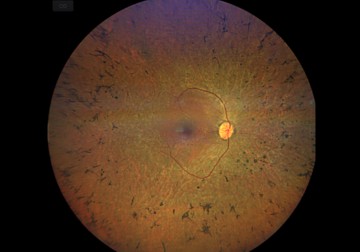Drs Deepika Parameswarappa, Rohit Khanna, Subhadra Jalali, Srinivas Marmamula, and others from L V Prasad Eye Institute publish a 15-year follow-up of retinitis pigmentosa (RP) patients from the longitudinal population-based Andhra Pradesh Eye Disease Study (APEDS). This study evaluates the incidence, visual impairment, and blindness due to RP from APEDS I to III.
Retinitis pigmentosa (RP) is an inherited (genetic) eye condition involving the retina. It is characterized by the progressive degeneration of the photoreceptor cells in the retina and the underlying retinal pigment epithelium that nourishes those cells. RP is a progressive disease and leads to gradual vision loss, with a majority of the patients becoming legally blind by young adulthood. Mutations across multiple genes are responsible for RP. A person with RP presents with night blindness and a gradual, constricting field of vision within their first two decades of life. This loss can be quite debilitating for the person affecting quality of life and productivity. Today, there is only one US FDA approved gene therapy for RP, while other treatment options are under clinical trials.
India reports a higher prevalence of Retinitis Pigmentosa when compared to other countries. South India, with its long history of consanguinity, may explain this higher prevalence as there is a strong association of consanguineous family history with RP. Compared to a 1 in 3000-7000 prevalence elsewhere in the world, rural south India reports an RP prevalence of 1 in 1000. The 15-year follow up of the Andhra Pradesh Eye Disease Study (APEDS) noted that RP was the second important cause of incident blindness in south India. For conditions with such complex genesis and progression in a population, the prevalence alone is inadequate; it is important to understand the addition of new cases to the population, and the progression of the disease over time. However, longitudinal studies that capture incidence and disease progression are expensive, and scarce in low- and middle-income countries.
A new paper in the Indian Journal of Ophthalmology by Deepika Parameswarappa, Rohit Khanna and others evaluates the incidence of vision loss due to RP based on a longitudinal cohort study from APEDS cohorts I and III over 15 years. In APEDS I (1996-2000), 7771 rural participants were examined, and nine were identified to have RP (0.12%). After 15 years, 7 of the original 9 were identified and reexamined as part of APEDS III (2012-2016). Two new cases (they were normal 15 years ago) were identified in APEDS III leading to an RP incidence of 24.7 per million in this population. There was a preponderance of males, and most of the patients identified were of working age.
All patients with RP had a significant decline in vision over time. The study found that those who began 15 years ago with moderate impairment saw the most decline in vision. A majority of the patients (5/9) with RP went blind during the 15 years. The study also found that the vision loss of RP patients was severe in their middle years and reached a ‘ceiling effect’ by the later years. Thus, this study uniquely provides the burden of RP and the natural history of this blinding condition in a southern Indian rural population. It provides evidence to plan for genetic testing, counselling, and rehabilitation services for people with RP at a large scale.
‘The future impact of this study should be on developing appropriate strategies to either prevent this condition by increased awareness of the link between RP-like genetic conditions and consanguineous marriages,’ says Dr Deepika Parameswarappa, the lead author and consultant ophthalmologist at the Anant Bajaj Retina Institute, LVPEI. ‘Stepping up genetic counselling centers and reducing the cost of genetic testing, along with low vision and rehabilitation services, especially in rural India should be a priority. The ultimate goal should be to treat RP patients very early in life and provide affordable gene therapy or stem cell therapy so that their quality of life is preserved.’
Citation
Parameswarappa DC, Jalali S, Marmamula S, Natarajan R, Mettla AL, Giridhar P, Banerjee S, Shekhar K, Chakrabarti S, Khanna RC. Visual impairment and blindness due to retinitis pigmentosa in India: 15-year follow-up of the Andhra Pradesh Eye Disease Study cohort. Indian J Ophthalmol. 2023 Mar;71(3):902-908. doi: 10.4103/ijo.IJO_1610_22. PMID: 36872706.
Photo credit: LVPEI



